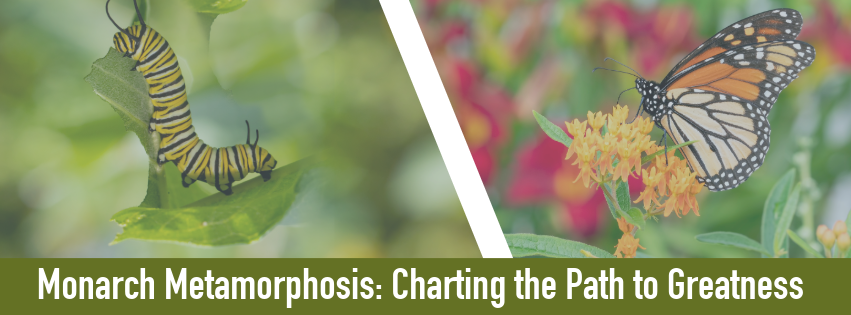
From Tiny Eggs to Majestic Wings: The Monarch Butterfly’s Incredible Story
Time Frame: 3-5 days
Starting out as tiny, round, white eggs about the size of a pinhead, monarch butterflies lay their eggs exclusively on milkweed—the only plant their caterpillars eat.
Milkweed contains toxins called cardenolides (a type of cardiac glycoside), which are harmful to most animals but essential for monarchs. When monarch caterpillars feed on milkweed, they store these toxins in their bodies, making them toxic and unpalatable to predators.
It’s the only food that gives their caterpillars the nutrients they need to grow while also providing a built-in defense system! Without milkweed, monarchs wouldn’t be able to survive through their caterpillar stage
Fun Fact: A female monarch can lay up to 500 eggs in her lifetime!
Time Frame: 10-14 days
Once hatched, the tiny caterpillar enters the ultimate growth phase. It immediately starts voraciously eating its milkweed home. The caterpillar’s main job? A non-stop eating party, with a side of personal transformation! It will shed its skin five times because it just can’t stop growing.
Fun Fact: A caterpillar can increase its body mass by 2,000% in just two weeks!
Time Frame: 10-14 days
Here’s where things get seriously cool. When ready, the caterpillar hangs upside down in a “J” shape and spins a silky thread to form a chrysalis. Inside this jade-green chrysalis, an extraordinary transformation occurs. The caterpillar’s body breaks down into a soupy mess and reorganizes into a butterfly. It’s the ultimate transformation, complete with a temporary identity crisis.
Fun Fact: You can spot gold spots on the chrysalis, these spots are believed to serve as reflective structures that aid in thermoregulation.
Time Frame: Minutes to hours
After about two weeks, the chrysalis darkens, and the butterfly inside becomes visible. The monarch emerges, having completed its hard work and transformation, but it’s still not quite ready for takeoff.
Monarch butterflies can’t fly right away after emerging because their wings are still soft, wet, and crumpled from being packed inside the chrysalis.
During this time, the butterfly will hang upside down to let gravity help the process. Once their wings are dry and ready, they’re good to go! It’s kind of like stretching after a long nap—everything needs a little time to unfold before they’re ready to fly. Life’s like that sometimes—you need to give yourself a minute to get your wings in working order before you can soar.
Fun Fact: After they emerge, they need time to pump hemolymph (their version of blood) into their wings to expand and harden them. It can take several hours for their wings to fully dry and strengthen enough for flight.
Time Frame: 2-6 weeks (or up to 8 months for the long-distance travelers)
Now fully dried and ready to go, the butterfly is prepared to take on the world, looking for nectar and mates. If they’re in the migratory generation, they are getting ready for a 3,000-mile road trip to Mexico! They go from binge-eating homebody to globe-trotting adventurer.
In Aztec mythology, butterflies were thought to be the souls of warriors, transformed into something that would live forever. In some Mexican cultures, they’re believed to carry the souls of loved ones—the ultimate spiritual messengers, reminding us that life is a cycle of transformation and renewal.
Fun Fact: Monarchs can live longer if they’re part of the migrating generation—up to 8 months instead of the usual few weeks.
Why Monarchs Matter: The Butterfly Effect (Literally)
Monarch butterflies aren’t just pretty—they play a crucial role in our ecosystem. As pollinators, they help plants reproduce, which in turn supports entire food chains. Without monarchs (and other pollinators), the balance of our ecosystems would be totally thrown off. Plus, their epic migrations are a marvel of nature, inspiring conservation efforts worldwide. Monarchs remind us that even the smallest creatures can make a huge impact.

